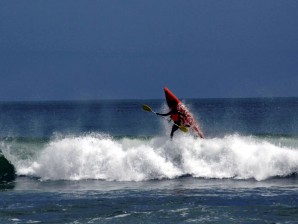Surf kayaking thrills Camarines Norte

A PARTICIPANT loses the battle against the waves in a surf kayaking race, the second leg of the Philippine Kayaking Series 2011 in the weeklong “Kadagatan (Ocean) Festival” in Mercedes, Camarines Norte. DAX ALAN CRUZ/CONTRIBUTOR
MERCEDES, Camarines Norte—The lowly “paraw” in the bustling fishing town of Mercedes in Camarines Norte has given way to the kayak.
Commonly used by poor fishermen in the seaside towns of Camarines Norte, the paraw is a 4-meter-long wooden boat with a paddle and sail. It is similar to the kayak in overall structure, but the latter is usually made of reinforced plastic.
The kayak has a dent or “cockpit” for the paddler and a covered deck that allow it to roll over the waves as a surfboard does. It is just the right vessel for a surf kayaking race in Mercedes on Aug. 7.
The race was the second leg of the annual Philippine Kayaking Series 2011 (the first was held in Anvaya Cove in Zambales). It was also a main event in the weeklong “Kadagatan (Ocean) Festival” that paid tribute to the fishing industry in Mercedes, a main source of livelihood for most of its 41,713 people.
Fourteen two-man teams, some of whom coming from Batangas province, paddled all the way to the coast of Mercedes in the 15-kilometer race.
Article continues after this advertisement3-island route
Article continues after this advertisementStarting point was Caringo, an island barangay endowed with fine sand beaches. The kayakers went through the channel between the Quinapaguian Island and coast of Barangay Mambungalon (located in mainland Mercedes) and headed for the Canimog Island until they reached Baybay Beach in the town proper.
A test of strength and stamina of the participants, the race was mainly a sea kayaking event from Caringo. It only turned into surf kayaking at the end point, where the shallow seabed, strong current and winds produced crushing high waves. The paddlers had to glide through the crests and troughs of successive waves before reaching the shore.
“To cut through the sea smoothly, we needed to move in accordance with the waves. There should be timing,” said Julio Casalo, 49, one of the paraw fishers who competed.
Eighteen other locals, most of whom are paraw fishers, joined the competition and had to be at par with the professional kayakers. Some made it to the beach without their kayaks as they fell from their vessels while being tossed by the waves.
All participants were required to wear protective gears, such as life vests, and they were accompanied by six marshals and a rescue team.
After almost two hours, the team led by Reneric Moreno, 30, a professional kayaker, emerged winner. It took him and his buddy one hour, 49 minutes 45 seconds to reach the shore.
Stamina, fun
“The most important in this watersport is stamina. You should also have a very strong and agile upper body to endure hours of paddling and going against the waves,” Moreno said.
Those who want to try the sport must know that it is more fun than scary, he said
“One of the objectives of the race, aside from promoting kayak-surfing (or surf kayaking), is the promotion of ecotourism and environmental conservation,” said Andrea Camara, one of the race organizers.
“We also want to prop up Mercedes as a kayak-surfing destination,” she said.
Camara said the Mercedes group of islands is comparable to the Hundred Islands in Pangasinan, a famous kayaking location in the Ilocos region, as a suitable site for the water sport.
The three islands in the race route—Caringo, Quinapaguian and Canimog—along with the Apuao Islands, are collectively known as the Mercedes group of islands.
It will form a triumvirate with the Calaguas group of islands in Vinzons town and Bagasbas Beach in Daet, according to Debbie Francisco, provincial tourism officer.
Livelihood project
The Calaguas is home to powdery, white-sand beaches while Bagasbas is a venue for kiteboarding, a water sport in which the player lets a kite harnessed to the middle part of his body pull him over the surface of a body of water while riding a surfboard.
Francisco said officials in Mercedes would make surf kayaking a livelihood project. The municipality has bought eight kayaks to be rented out to tourists.
Most important, she said, the surf kayaking industry would encourage the residents, especially those in coastal villages, not to throw garbage into the sea.
“When they see that tourists are making use of the sea for surf kayaking and that the tourism industry is helping them, they would realize that they should protect the sea and keep it free from pollution,” Francisco said.